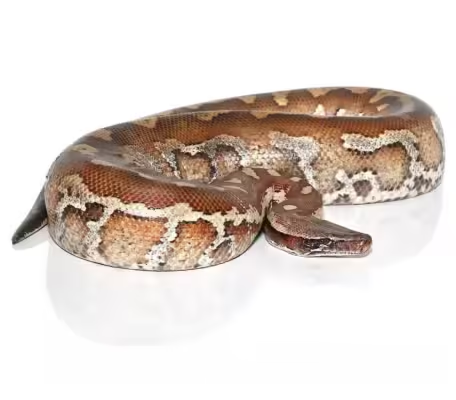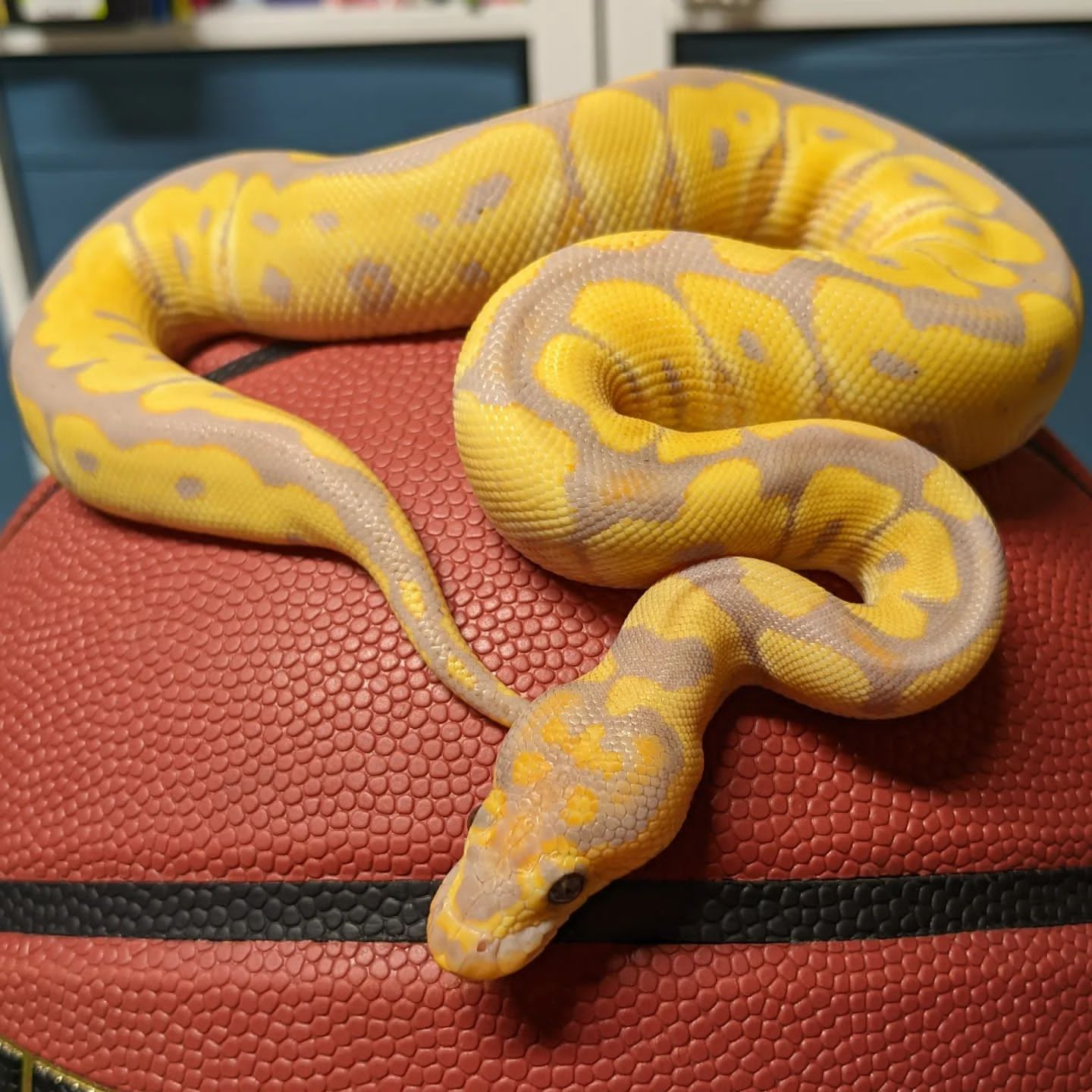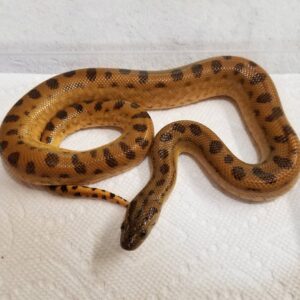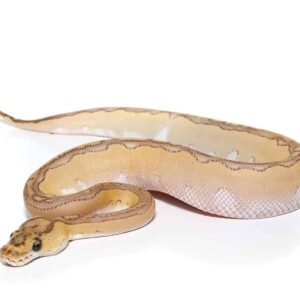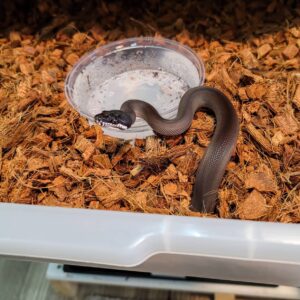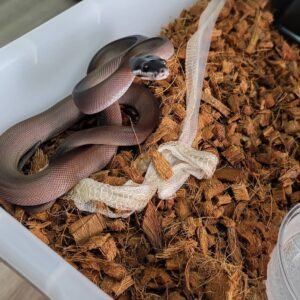Sumatran Blood Python For Sale
$349.99
WE HAVE SUMATRAN BLOOD PYTHON FOR SALE. HERE ARE SOME HIGHLIGHTS:
- Python brongersmai
- Captive Bred
- Males and Females
- Approximately 4′ Feet In Length
- This Species Can Be Feisty But With Regular Handling Tames Down Well
- Voracious Little Hunters Feeding On Live And Frozen Large Rats Weekly
FUN FACTS!
- Originating From The Island Of Borneo And Sumatra In Indonesia
- Adults Will Average In Lengths Around 4-5 Feet
- With Proper Care These Snakes Can Live Up To 20-25 Years At A Time
- Blood Pythons Are Terrestrial Snakes Living Their Lives On The Forest Floor Blending In With The Leaf Litter And Attacking Prey By Surprise
Description
The Sumatran Blood Python, scientifically known as Python brongersmai, is a remarkable species native to the lush forests and extensive wetlands of Sumatra, an Indonesian island renowned for its biodiversity. These pythons are distinguished by their robust bodies and striking appearance, which make them a subject of fascination among both herpetologists and snake enthusiasts. One of the most captivating features of the Sumatran Blood Python is its vivid coloration, which can range from deep red to brown, often with intricate patterns and markings that add to its allure.
Physically, the Sumatran Blood Python is characterized by its thick, muscular build, which is not only visually impressive but also indicative of its strength. Adult specimens typically grow to lengths of three to five feet, although larger individuals have been recorded. The scales of the Sumatran Blood Python are smooth and glossy, further enhancing its striking visual appeal. This species’ coloration and patterns provide effective camouflage in its natural habitat, aiding in its survival and hunting.
In addition to its physical attributes, the Sumatran Blood Python holds a significant place in local culture and mythology. Indigenous communities often revere these snakes, attributing various symbolic meanings to their presence. Furthermore, the Sumatran Blood Python has gained considerable popularity in the exotic pet trade, owing to its manageable size and relatively calm temperament compared to other python species. However, it is crucial for potential owners to comprehend the specific care requirements and ethical considerations involved in keeping such a unique reptile.
Overall, the Sumatran Blood Python is a fascinating creature that embodies the rich biodiversity of its native habitat. Its striking appearance, combined with its cultural significance and popularity among snake enthusiasts, underscores the need for continuing conservation efforts to protect this extraordinary species and its environment.
Physical Characteristics
The Sumatran Blood Python, scientifically known as Python brongersmai, is a striking species renowned for its distinctive physical attributes. On average, this python ranges between 4 to 6 feet in length, with some exceptional individuals exceeding 7 feet. This size makes the Sumatran Blood Python a relatively large snake, though not the largest among pythons.
The most notable feature of the Sumatran Blood Python is its coloration. The name “blood python” is derived from its vibrant blood-red hue, which varies in intensity among individuals. This coloration is complemented by patterns of black, brown, and orange, creating a visually captivating appearance. The scales of the Sumatran Blood Python are smooth and glossy, contributing to its sleek and formidable look.
In terms of head shape, the Sumatran Blood Python has a broad, triangular head that distinguishes it from other python species. Its eyes are relatively small but keen, aiding in its nocturnal hunting activities. The python’s muscular build is another defining characteristic; it possesses a robust body that is well-suited for its constricting hunting technique. The powerful muscles allow it to immobilize and subdue prey effectively.
Sexual dimorphism, or the differences in appearance between males and females, is present in this species but is not as pronounced as in some other reptiles. Typically, females tend to be larger and more heavily built than males, which is advantageous during reproduction, as females require more body mass to produce and incubate eggs.
Overall, the physical characteristics of the Sumatran Blood Python not only contribute to its allure but also play a crucial role in its survival and hunting strategies. This combination of size, coloration, and muscular strength makes the Sumatran Blood Python a fascinating and formidable predator in its natural habitat.
Natural Habitat and Distribution
The Sumatran Blood Python, a distinctive species native to the island of Sumatra, thrives in a variety of specific environments. Predominantly found in the tropical rainforests, this snake also occupies marshes and swamps, where the humidity levels are high and the temperature remains consistently warm. These lush, dense forests provide ample cover and opportunities for the python to hunt and remain concealed from predators.
Sumatra’s tropical rainforests, characterized by their rich biodiversity and dense canopy cover, create an ideal habitat for the Sumatran Blood Python. The forest floor, littered with leaf debris and fallen logs, offers excellent camouflage for this species, aiding in its ambush hunting strategy. Additionally, the presence of water bodies such as rivers, streams, and swamps in these areas is crucial, as the Sumatran Blood Python often frequents such locations to regulate its body temperature and hydrate.
Beyond the dense forests, these pythons are also found in marshes and swamps, environments that support a variety of prey species. The semi-aquatic nature of the Sumatran Blood Python allows it to exploit these wetland habitats effectively. Here, the python’s behavior and lifestyle are influenced significantly by the availability of prey and the need for moisture, making these regions vital for its survival.
However, the natural habitat of the Sumatran Blood Python faces significant threats. Deforestation, driven by logging, agricultural expansion, and urban development, poses a severe risk to these environments. The resulting habitat fragmentation not only reduces the available living space for these pythons but also disrupts their ability to hunt and reproduce. Human encroachment further exacerbates these issues, leading to increased encounters with humans and potential conflicts.
Conservation efforts are critical in addressing these threats. Protecting the remaining tropical rainforests and wetlands in Sumatra, and promoting sustainable land-use practices, are essential steps in preserving the natural habitat of the Sumatran Blood Python. By mitigating the impacts of deforestation and human activities, we can ensure the survival of this fascinating species in its natural environment.
Diet and Hunting Behavior
The Sumatran Blood Python, a fascinating species native to Southeast Asia, exhibits a varied and opportunistic diet. Primarily, this python preys on small mammals such as rodents, birds, and occasionally other reptiles. The selection of prey is largely influenced by the python’s environment and the availability of food sources. In the wild, the Sumatran Blood Python is an adept ambush predator, relying heavily on its natural camouflage to blend seamlessly into its surroundings. Its reddish-brown coloration and intricate patterning allow it to remain concealed within the forest floor or amidst foliage, making it nearly invisible to unsuspecting prey.
The hunting technique of the Sumatran Blood Python is both strategic and efficient. Utilizing its muscular build and powerful constriction abilities, the python lies in wait for an opportune moment to strike. Once prey is within range, the python employs a swift and precise attack, using its sharp teeth to secure the prey before coiling its robust body around it. The constriction is methodical, applying pressure until the prey is subdued and ready for consumption.
Interestingly, the feeding behavior of the Sumatran Blood Python in captivity can differ from that in the wild. In a controlled environment, such as a zoo or a private collection, these pythons are often provided with a consistent and varied diet, which may include pre-killed rodents and birds. This regular feeding schedule can sometimes lead to more predictable feeding patterns, contrasting with the sporadic and opportunistic feeding habits observed in their natural habitat. Additionally, captive pythons may display unique behaviors such as increased food response or reduced feeding intervals, influenced by the controlled and relatively stress-free environment.
Overall, the Sumatran Blood Python’s diet and hunting behavior are a testament to its adaptability and survival skills. Its combination of physical attributes and strategic hunting techniques underscores the intricate balance of predator and prey within its ecosystem. Whether in the wild or in captivity, the Sumatran Blood Python continues to captivate researchers and enthusiasts alike with its remarkable predatory prowess.
Reproductive Behavior
The reproductive cycle of the Sumatran Blood Python is a captivating aspect of its biology, revealing intricate mating rituals and dedicated parental care. Mating typically occurs during the cooler months, with males engaging in combat for the opportunity to mate with a receptive female. This combat involves physical displays of strength and endurance, where males intertwine and wrestle, showcasing their prowess.
Once a successful mating occurs, the female undergoes a gestation period of approximately 90 days. During this time, she exhibits a marked change in behavior, often becoming more reclusive and less active. This period is crucial for the development of the embryos within her, and she carefully regulates her body temperature to ensure optimal conditions for their growth.
Upon the conclusion of the gestation period, the female typically lays between 12 to 30 eggs, though the exact number can vary based on her size and health. The incubation process is particularly fascinating, as the female exhibits a high degree of maternal care. She coils around the eggs, using her body to maintain a stable temperature and protect them from potential predators. This behavior is vital in the wild, where environmental conditions can be unpredictable.
During the incubation period, which lasts about 60 to 70 days, the female rarely leaves the nest, prioritizing the safety and development of her offspring. In captivity, breeders often replicate these conditions to ensure high hatching success rates. Observations have noted that the female blood python may exhibit aggressive behaviors to ward off any perceived threats, further highlighting her protective instincts.
Interestingly, both in the wild and captivity, the breeding season of the Sumatran Blood Python is marked by heightened activity and territoriality. Males are more visible as they search for mates, and females are more vigilant. These behaviors underscore the importance of this period in the life cycle of the species, ensuring the successful continuation of their lineage.
Care and Husbandry in Captivity
Keeping Sumatran Blood Pythons as pets requires attention to their specific habitat needs to ensure their well-being. An appropriately sized enclosure is paramount; adult Sumatran Blood Pythons should be housed in a terrarium that is at least 4 feet long, 2 feet wide, and 2 feet tall. This provides sufficient space for them to move and stretch comfortably.
Temperature regulation is crucial for these reptiles. Their enclosure should have a thermal gradient, with a basking spot maintained between 88°F to 92°F and a cooler side ranging from 78°F to 82°F. Nighttime temperatures can safely drop to around 75°F. Using thermostats to control heating devices is recommended to prevent overheating and ensure a stable environment.
Humidity levels should be kept between 60% and 70% to mimic their natural habitat. Regular misting and the inclusion of a large water bowl can help maintain proper humidity. For substrate, options such as cypress mulch, coconut husk, or aspen bedding are ideal as they retain moisture and facilitate burrowing behaviors.
Dietarily, Sumatran Blood Pythons thrive on a diet of appropriately sized rodents. Juveniles should be fed once a week, while adults can be fed every 10 to 14 days. It’s important to adjust the size of the prey according to the snake’s girth to prevent overfeeding and potential health issues.
Regular health checks are vital to detect and manage common health problems, such as respiratory infections, parasites, and scale rot. Observing for symptoms like wheezing, lethargy, or abnormal shedding is essential. A yearly visit to a reptile-savvy veterinarian can help maintain their overall health.
The temperament of Sumatran Blood Pythons can vary; while some individuals are docile, others may be more defensive. Consistent, gentle handling can help acclimate your python to human interaction. Always support their body fully during handling to reduce stress and prevent injury. Understanding these care essentials will ensure a thriving and healthy pet.
Common Myths and Misconceptions
There are numerous myths and misconceptions surrounding the Sumatran Blood Python, often painting an inaccurate picture of these fascinating creatures. One of the most prevalent myths is that these pythons have an aggressive temperament. Contrary to this belief, Sumatran Blood Pythons, when properly socialized and cared for, can exhibit calm and docile behavior. Like any wild animal, their initial response to perceived threats may be defensive, but with consistent handling, they can become more accustomed to human interaction.
Another common misconception is that Sumatran Blood Pythons pose a significant danger to humans. While it is true that they are powerful constrictors, these pythons are not inherently dangerous to people. They do not seek out human interaction and, when left undisturbed, are generally non-aggressive. The risk of a harmful encounter is minimal when proper handling techniques are employed, and their natural behavior is respected.
Additionally, there is often a misunderstanding regarding the care requirements of Sumatran Blood Pythons. Some believe that these reptiles are difficult to manage and require overly complex care routines. In reality, while they do have specific needs in terms of habitat, temperature, and humidity, these requirements are not excessively burdensome for a well-informed owner. Providing a stable environment, proper nutrition, and regular health check-ups can ensure a healthy and thriving python.
Educating potential owners and the public about the true nature of the Sumatran Blood Python is crucial to dispelling these myths. Understanding that these animals are not the aggressive and dangerous creatures they are often made out to be can foster better appreciation and responsible ownership. Awareness and education can lead to a more informed and respectful interaction with these remarkable reptiles, highlighting their unique characteristics and the importance of their conservation.
Conservation Efforts and Ethical Considerations
The Sumatran Blood Python (Python brongersmai) is a species that has garnered significant attention due to its distinctive appearance and ecological importance. Currently, the Sumatran Blood Python is not listed as endangered, yet it faces several threats that necessitate active conservation efforts. Habitat destruction, primarily due to deforestation for agricultural development, poses the most significant risk to its natural population. Additionally, illegal wildlife trade continues to challenge conservation initiatives, despite existing regulations.
Various wildlife conservation organizations are at the forefront of efforts to protect the Sumatran Blood Python. These organizations work tirelessly to monitor populations, enforce anti-poaching laws, and promote habitat preservation. Legal protections, such as those enforced by the Convention on International Trade in Endangered Species of Wild Fauna and Flora (CITES), aim to regulate and minimize the impact of international trade on this species. However, enforcement of these laws remains a formidable task, requiring constant vigilance and cooperation from local communities and governments.
Ethical considerations also play a crucial role in the conservation of the Sumatran Blood Python, particularly regarding its captivity. Responsible breeding practices are paramount to ensure the health and well-being of captive-bred individuals. This involves maintaining genetic diversity, providing adequate living conditions, and preventing overbreeding. Moreover, supporting conservation initiatives through donations or by purchasing from reputable breeders who contribute to conservation efforts can make a significant difference.
Individuals who keep Sumatran Blood Pythons as pets must recognize the importance of supporting sustainable practices. This includes becoming educated on the species’ needs, participating in conservation programs, and advocating for stronger legal protections. By fostering a deeper understanding and respect for the Sumatran Blood Python, enthusiasts and conservationists alike can work together to ensure the survival and thriving of this remarkable species in the wild.
